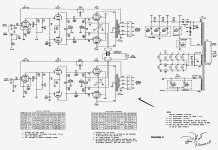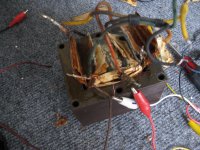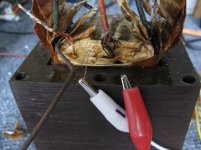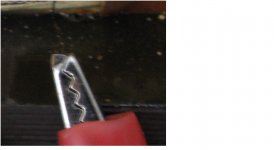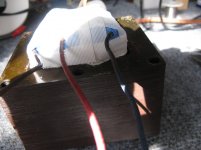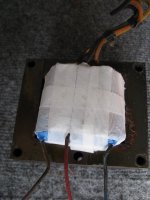I’m in the process of rebuilding a Citation V amplifier and last nite while taking resistance readings with tubes pulled, I noticed channel B had an open condition from the OPT (blue wire) to pin 3 of the 7581 V8 tube and its connection to C1 via the (red wire). Comparative readings from channel A to channel B match otherwise.
Checked all the usual suspects i.e., broken wire, bad connection and etc. Finally cut both wires loose from their connections and took readings again; same situation exists. See schemy....
Could I have a bad OPT?
Thanks all.
Checked all the usual suspects i.e., broken wire, bad connection and etc. Finally cut both wires loose from their connections and took readings again; same situation exists. See schemy....
Could I have a bad OPT?
Thanks all.
Attachments
Last edited:
From what you describe it is possible that you do have a bad OPT.. Take the end bells off and see if there is anything obvious, probably not reparable but you never know until you have a look. I'm assuming there is continuity from the center tap to the other plate lead?
A set of Edcor OPTs might be the ticket to getting this amp going again for reasonable money. Some work on the compensation scheme may be necessary. (R8/C15, and C6)
A set of Edcor OPTs might be the ticket to getting this amp going again for reasonable money. Some work on the compensation scheme may be necessary. (R8/C15, and C6)
Yes, the OPT could be bad - if so there is a likelihood that the failure is not the core windings but where the lead wires are brought out. As Kevin said, if you remove the bell ends you may be able to see and fix the problem. After 50 years it's entirely possible something has gone wrong!
If not I STRONGLY recommend you get them repaired rather than replace them. Get them rewound if need be if a simple repair isn't possible.
There are a number of rewinders around, but Doc Hoyer (autran@aol.com) is very good (and not cheap). Heyboer is another high quality possibility.
IMHO, that amp is worth the investment.
If not I STRONGLY recommend you get them repaired rather than replace them. Get them rewound if need be if a simple repair isn't possible.
There are a number of rewinders around, but Doc Hoyer (autran@aol.com) is very good (and not cheap). Heyboer is another high quality possibility.
IMHO, that amp is worth the investment.
Last edited:
From what you describe it is possible that you do have a bad OPT.. Take the end bells off and see if there is anything obvious, probably not reparable but you never know until you have a look. I'm assuming there is continuity from the center tap to the other plate lead?
A set of Edcor OPTs might be the ticket to getting this amp going again for reasonable money. Some work on the compensation scheme may be necessary. (R8/C15, and C6)
Yes, the OPT could be bad - if so there is a likelihood that the failure is not the core windings but where the lead wires are brought out. As Kevin said, if you remove the bell ends you may be able to see and fix the problem. After 50 years it's entirely possible something has gone wrong!
If not I STRONGLY recommend you get them repaired rather than replace them. Get them rewound if need be if a simple repair isn't possible.
There are a number of rewinders around, but Doc Hoyer (autran@aol.com) is very good (and not cheap). IMHO, that amp is worth the investment.
Kevin and Jim,
Yep, continuity from the center tap to the other plate lead. I plan on going into surgery tomorrow, with any luck maybe the problem is near the surface. Yeah, like that's gonna happen...I'm gonna win the lottery too! I'll let you guys know how this turns out.
Ohmed out looks like this now:
R to BL *0*
R to BN 118
BL to BN 228
Hi Jim!!...it's Kim
Best regards to you and your family.
Kim
Yep, continuity from the center tap to the other plate lead. I plan on going into surgery tomorrow, with any luck maybe the problem is near the surface. Yeah, like that's gonna happen...I'm gonna win the lottery too! I'll let you guys know how this turns out.
Maybe things will go your way. Somebody else had symptoms like those you've encountered and "came up smelling like a rose". Look here.
Kico -- in your last post you show the reading for the R to BL leads as "0", which implies a dead short, yet I think you are indicating that the connection is actually a complete open, as in no reading at all. I mention all of this only against the backdrop that you also indicate that there still is a rather normal indication existing between to two plate leads (BL and BN).
If that is the case, then that implies that the basic winding is still in tack, and the problem may in fact be where the B+ lead is attached to the two primary halves. On the other hand, it is almost impossible for there to be an open condition from (only) one plate lead to the B+ lead, yet still have a normal resistance reading between the two plate leads -- Unless, is the original problem the fact that the winding is in fact 0 ohms (shorted)? Or is it in fact open, as in infinite resistance?
Hoping for the best for you.
Dave
If that is the case, then that implies that the basic winding is still in tack, and the problem may in fact be where the B+ lead is attached to the two primary halves. On the other hand, it is almost impossible for there to be an open condition from (only) one plate lead to the B+ lead, yet still have a normal resistance reading between the two plate leads -- Unless, is the original problem the fact that the winding is in fact 0 ohms (shorted)? Or is it in fact open, as in infinite resistance?
Hoping for the best for you.
Dave
Update...
Ok, everyone…Been two hours in and four layers down working very gently with a razor blade to cut each paper layer and have found the problem; a broken wire in the transformer to the (blue) lead out wire. There was only a very small piece of the wire left extending from the TX, maybe 1/4 inch.
I managed to remove enough of the lacquer coating to get a jumper on the wire stub to get a reading. Not really expecting too much, I was surprised to see my DMM come alive with a reading of (108 ohms R to BL) can I really fixed this thing? If I could believe my eyes, my “want to” skills and meter then the possible answer was a big YES!
I immediately checked between the other inputs and got the following:
BL-BN 228 Ohms
BN-R 118 Ohms
And the one to be repaired BL-R 108 Ohms
The diameter of this wire is "soooo" small and it was so short/fragile, I was leery to do anything but look at it and ponder the how to fix step. Under a magnifying glass and with a pair of small needle point surgical tweezers I was able to make a small fishhook on the end and using another piece of slightly larger wire with a fishhook on its end, was able to interlock the two.
I figured I had one shot with the iron. Touched the joint and small drop of solder joined the two and under the glass it looked like a decent joint. Checked with meter again and I still had continuity. I readjusted all the TX leads and attached them with hot glue to keep them from moving. Then in turn attached the larger core wires bundles and sandwiched and glued each one between the layers of original paper one at a time.
Finished with two coats of lacquer and some of the stickiest moisture resistant surgical tape (how appropriate
 ) you’ve ever seen. Two more coats of lacquer and I have finished! So I got lucky this time and got the Bear…God knows he gotten me enough times!
) you’ve ever seen. Two more coats of lacquer and I have finished! So I got lucky this time and got the Bear…God knows he gotten me enough times!
Last question—is there a way to reasonably to test this repair without installing it back in the amp?
Thanks all.
Ok, everyone…Been two hours in and four layers down working very gently with a razor blade to cut each paper layer and have found the problem; a broken wire in the transformer to the (blue) lead out wire. There was only a very small piece of the wire left extending from the TX, maybe 1/4 inch.
I managed to remove enough of the lacquer coating to get a jumper on the wire stub to get a reading. Not really expecting too much, I was surprised to see my DMM come alive with a reading of (108 ohms R to BL) can I really fixed this thing? If I could believe my eyes, my “want to” skills and meter then the possible answer was a big YES!
I immediately checked between the other inputs and got the following:
BL-BN 228 Ohms
BN-R 118 Ohms
And the one to be repaired BL-R 108 Ohms
The diameter of this wire is "soooo" small and it was so short/fragile, I was leery to do anything but look at it and ponder the how to fix step. Under a magnifying glass and with a pair of small needle point surgical tweezers I was able to make a small fishhook on the end and using another piece of slightly larger wire with a fishhook on its end, was able to interlock the two.
I figured I had one shot with the iron. Touched the joint and small drop of solder joined the two and under the glass it looked like a decent joint. Checked with meter again and I still had continuity. I readjusted all the TX leads and attached them with hot glue to keep them from moving. Then in turn attached the larger core wires bundles and sandwiched and glued each one between the layers of original paper one at a time.
Finished with two coats of lacquer and some of the stickiest moisture resistant surgical tape (how appropriate

Last question—is there a way to reasonably to test this repair without installing it back in the amp?
Thanks all.
Attachments
Kim,
Do you have a variac? If so you can use it as the signal source to test the OPT.
Hey Jim,
Yep I do--set at 50V--got 50.1V across one half the primary and 49.9 across the other half; so things are looking good for now.

BTW, just sold a rebuilt PAS3-X to a neighbor of yours in Park Ridge, IL. Private sale and a very handsome price with no auction site fees. Maybe I'll order one of "them thar" HK kits you sell.
Take care and many thanks!
Kim
Congratulations on a well done repair. I've done such a repair myself on more then one transformer in years past. If I were you, I'd strongly consider installing a ¼ amp fuse between each of the transformers center tap leads and B+. Especially if you're using todays tubes. 
- Status
- This old topic is closed. If you want to reopen this topic, contact a moderator using the "Report Post" button.
- Home
- Amplifiers
- Tubes / Valves
- Citation V OPT Diagnosis/Question...
